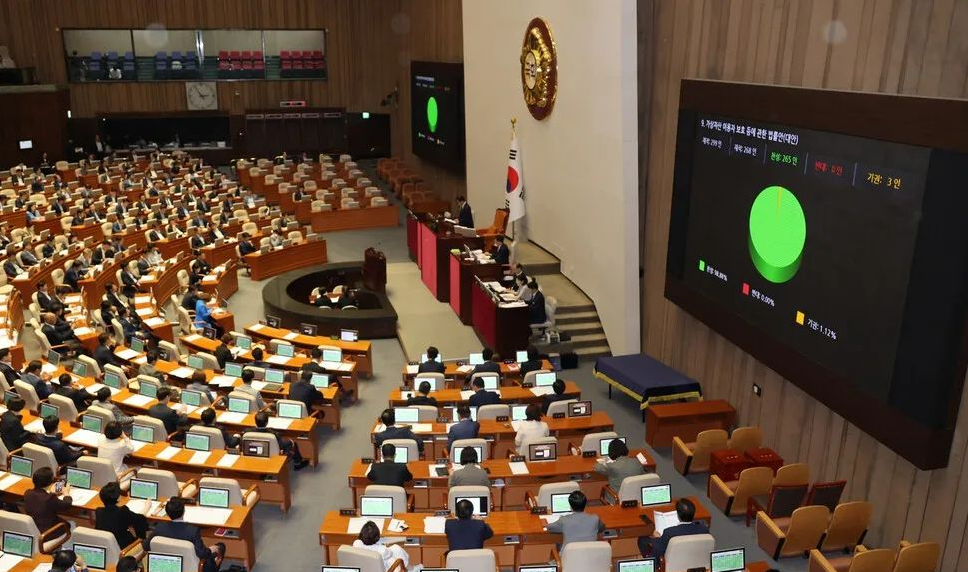DCEP vs Libra: Digital Currency Competition in the Context of Globalization
Source: TokenGazer
Libra kicks off
Libra's mission is to create a simple, borderless currency and financial infrastructure that serves billions of people. Libra is made up of three parts that will work together to create a more inclusive financial system:
- It is based on a secure, scalable and reliable blockchain;
- It is backed by an asset reserve that gives it intrinsic value;
- It is managed by an independent Libra association whose mission is to promote the development of this financial ecosystem.
schedule:

- ETH 2.0 is coming online, what are the main changes?
- “Agriculture + Blockchain”: from farm to table, from sowing to inclusive finance
- Nakamoto is coming again, this time he has blonde hair and 250,000 bitcoins.
Since Facebook officially announced Libra, due to its extensive user base and potential financial impact, it has sparked a huge discussion on global stable currency. The main concerns can be summarized as follows:
Issuance mechanism and price stabilization mechanism
There are three main ways to issue digital currency stable coins: 1) face value issuance based on certain anchored liquid assets; 2) share issuance as an ETF (exchange-traded fund); 3) is based on the issuer's own credit endorsement. Libra's original plan was based on a basket of stable assets: the dollar, the euro, the pound, the yen, the Singapore dollar, and so on. But Marcus previously said that Libra, Facebook's cryptocurrency program, would have the potential to create a variety of cryptocurrencies based on a single currency (subdivided into US dollar stable, Euro stable, and Sterling stables, etc.) rather than originally based on a basket of currencies.
From regulatory feedback, including G7's opinion on GSC (Global Stabilization Coin), the mechanism for stabilizing the currency must ensure a fair and transparent pricing mechanism and secondary market operations. This includes the way in which the secondary market uses market makers to ensure liquidity and price stability. Libra uses a basket of stable asset designs and may face frontal trading, speculative and arbitrage opportunities, and potential conflicts of interest when its portfolio is rebalanced.
According to the Libra White Paper, the legal currency paid by users will be invested in “a series of low-volatility assets, including cash and government currency securities provided by a stable and reputable central bank”. However, users are not entitled to interest on Libra's investment assets. The interest return on the reserve assets will be “first used to pay for the association's operating expenses” and will then be used to “pay dividends to the initial investors of Libra's investment tokens”. ".
Because the global economy is always in an inflation state, and holding Libra does not enjoy interest, long-term holding of Libra will lead to a decline in asset purchasing power, which is not a wise choice. However, because Libra adopts a 100% reserve system and the value of holding assets is relatively stable, such properties will make Libra applicable in some countries with social turmoil and currency depreciation, and even replace some of the legal currency. At the same time, holding Libra tokens will also enjoy many benefits, such as convenient online payments, cheap cross-border transfers, and more.
From a credit system perspective, the legal currency deposit portion of Libra's reserve assets is at a higher risk relative to individual user deposits because, according to the FDIC US Federal Deposit Insurance Regulations, each depositor's general account for each bank receives a total of $250,000 from the Federal Reserve. There is no risk insurance coverage, and Libra's deposits will have to bear the credit risk of the bank itself.
Libra Progress
Since the official announcement of the Libra project in June this year, developers have released several blockchain browsers, such as Libranaut, Libraview, Librabrowser and Libexplorer; some projects have integrated the Libra test network into their wallets. , such as ZenGo. In addition, we have seen other blockchain projects that integrate the Move programming language into their own systems, such as Solana.
Stable technological developments, as well as open and transparent dialogue, are two key elements of developer interest in the Libra project. As Libra Core moves toward the main network step by step, its development roadmap has also been updated.

Above: Libra main network milestone
Test network follow-up work
The main purpose of Libra's launch of the test network is to make it easier for development teams to troubleshoot, diagnose, and resolve software extremes to quickly improve Libra Core. The test network has a range of Libra networking capabilities and also provides early access to developers. In the first milestone, the Libra Association is expected to invite five partners to deploy the full node on the network, and will launch the Libra main network in the fourth milestone phase, and the Libra Association expects 100 partners to run the Libra node.
Libra Pre-Mainnet
As the Libra project moves toward the main network milestone, it is necessary to keep the test network running while allowing more nodes to come online. To do this, the Libra team created a staging primary network environment called Pre-Mainnet. At this stage, only partner nodes can access Pre-Mainnet and allow them to connect to each other. A few partners have deployed nodes and can support communication with each other. Libra expects more partners to come online soon, and to ensure that the Libra network meets stringent performance benchmarks and overall system stability requirements before officially opening up to the new.
Libra governance
Libra uses a regulatory entity consisting of a diverse group of independent members who reside as a non-profit organization registered in Geneva, Switzerland. This entity is also responsible for the management of the Libra reserve. Facebook's own Calibra is a member of Libra and participates in Libra's governance. Its diverse, global membership brings a number of challenges to Libra.
On the surface, the Libra Association is a decentralized organization, but in fact many members have a good relationship with Facebook, and each member separates their responsibility from Libra. Facebook's goal is to develop 100 members, which are located in different regions and include non-profit organizations and academic institutions in addition to companies. Facebook will maintain its leadership role for the Libra Association by the end of 2019, but the association will have the final decision-making power through voting. The board of directors is composed of representatives of the members of the association, which in turn elects the board of directors.
The clarity of membership and powers and obligations. Libra's founding members come from many countries and industries, and different business lines and positions in the financial system determine the different demands of each member. Facebook has repeatedly stressed that it is only a member of Libra members, but from two US hearings, Facebook can undoubtedly assume leadership position in the entire project. How does this actual identity difference be expressed in power? And the process of governance is one of the problems that make American politics feel uncomfortable.
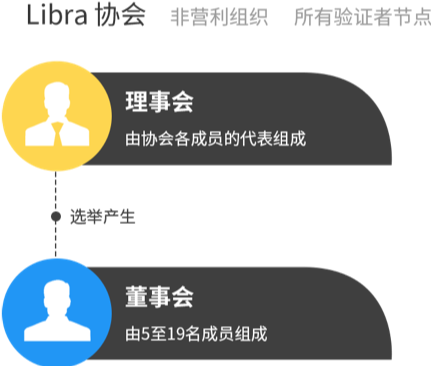
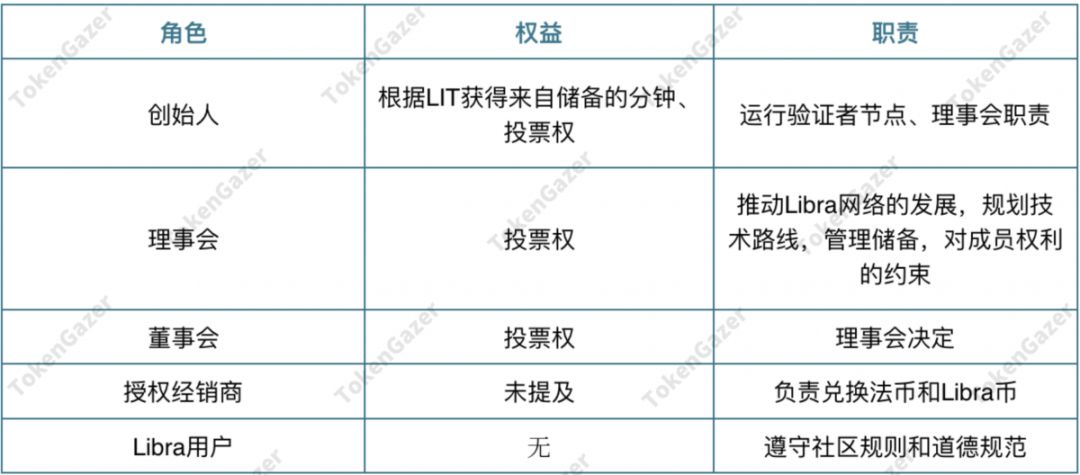
Impact on public policy
The asset structure and use of the stable currency itself will have a profound impact on the monetary policy of the major countries.
Libra's current design consists of a basket of assets, and Libra's own interest will be affected by the interest structure of its basket of assets. If a country's currency fails to become a part of Libra's basket of assets, or a small proportion, and the country is Libra's main user, then the adjustment of the country's monetary policy, the adjustment and transmission of central bank interest rates will inevitably face The possibility of failure.
This situation will be more serious in the countries where the country's own currency and exchange rate are more unstable. TokenGazer's research on the Bitcoin Google Search Index (see TokenGazer's official website) shows that in countries with more serious currency depreciation and lower economic stability, Bitcoin's search and interest index is higher, when a country clearly shows currency. When the trend of depreciation, the country's (regional) bitcoin search index usually shows a large increase. This kind of search feature on Bitcoin is very likely to appear on global stable coins as well.
For the case where the stable currency adopts a single sovereign state currency, in the country where the sovereign currency is located, such as China and the central bank digital currency DCEP, there is no effect of monetary policy transmission failure, but it may also face financial disintermediation, and the currency multiplier is invalid. The possibility, therefore DCEP takes a two-tier governance architecture. When the user converts the bank deposit into DCEP, the user's asset side writes down the bank deposit, the licensed bank's liability side writes down the user's bank deposit, the asset side writes down the reserve fund, and the central bank's debt end increases DCEP, and the overall on-balance sheet assets It is a process of shrinking the table. The overall impact of this process on finance has not been clearly and clearly analyzed.
The flow of funds for users to purchase Libra will be significantly different from DCEP. Libra is more likely to be an asset transfer between different accounts in a bank account, but there is a high probability that a major bank depositor will change from an individual to an institution, as a result of personal accounts to institutions. The account is transferred to French currency and converted to Libra. This change will also have a huge impact on the business model and profitability of the bank due to factors such as customer stickiness and sensitivity to changes in interest rates.
Supervision
Libra is positioned as a global stable currency, and Libra faces a multi-dimensional regulatory environment from the perspective of G7, the US government, and member businesses and countries:
- Because Libra's basket of assets sets Libra's release similar to ETFs, and Libra's own management of reserve assets, risk control, and potential conflicts between profit model and asset security, the US Securities and Exchange Commission (SEC) maintains a high level of Libra attention;
- As a global stable currency, Libra will most likely play an important role in international transfer payments. A range of existing standards and regulatory practices apply to Libra: CPMI-IOSCO Financial Market Infrastructure Principles promote safe and stable payment and clearing The environment, the quantification of risks in multilateral markets and participants, and the cybersecurity of financial market infrastructure will all have an impact on Libra participants;
- The FATF Financial Action Task Force on Anti-Money Laundering provides an effective framework for combating money laundering, terrorism-related financial activities, and other illegal financial activities. The FATF also proposes globally uniform regulatory standards for service providers of digital currencies;
- The Basel Committee on Banking Supervision also works on digital currency assets, including ongoing assessments of bank services and exposures to cryptocurrency assets;
- The Financial Stability Board FSB will work with a number of independent regulators to examine possible loopholes in the current regulatory system in the face of digital currencies and global stable currencies.
- Each Libra member may be faced with the regulatory requirements of the country in which the business is developed and the specific industry, due to its own business and country, including payment, hosting, and so on.
Countries also hold different views on Libra:
🇫🇷
France, the G7 presidency, has asked the European Central Bank Executive Committee to set up a G7 special group to delve into cryptocurrencies and digital coins like Libra.
During the G7 finance ministers and central bank governors meeting, French Finance Minister Bruno Le Maire said that “the sovereignty of each country cannot be compromised. Libra, which was recently announced to be launched, is clearly one of the concerns of the participants. It is agreed that it is necessary to act quickly."
🇩🇪
German Finance Minister Olaf Scholz said that the Facebook plan "doesn't seem to be well thought out," and there are data security issues. “I believe we must act quickly, and Libra cannot continue to advance without addressing all legal and regulatory issues.”
🇯🇵
Bank of Japan Governor Haruhiko Kuroda said that if Libra is to be used globally, countries must seek a global coordinated response mechanism. This is not something that can be discussed only by the G7 central bank.
🇺🇸
In the US, Fed Chairman Powell said at the semi-annual hearing of the US Congress on monetary policy that the Fed supports responsible and compliant innovation, but Libra has raised many serious questions about privacy, money laundering, consumer protection and financial stability. If they don't solve these problems, he doesn't think the project can move forward. Powell also mentioned that the Fed has established a working group to track the project and is coordinating with other central banks around the world.
US President Trump said unregulated crypto assets may facilitate illegal activities, including drug trafficking and other illegal activities. If Facebook and other companies want to become a bank, they must seek a new bank license and be subject to all banking regulations like other banks.
🇷🇺
Russian Deputy Finance Minister Alexei Moisseev said that the Russian Ministry of Finance will not make special provisions for Libra. “No one will ban it. On the other hand, in Russia, any form of cryptocurrency will not become legal tender. The ruble is our national currency, and all operations should use rubles. On the contrary, cryptocurrency will have similar to foreign currency. Status. People can buy, sell, and save it, but they can't use it to pay.” In short, Libra is not banned. Libra has a similar foreign currency status in Russia, but it cannot be used for payment.
🇪🇺
European Central Bank executive Moore said that Libra may reduce the ECB's control of the euro, weaken the transmission of monetary policy, and reduce the international influence of the euro, depending on the degree of Libra's license and the weight of the euro in the Libra reserve.
In September 2019, the attitude of Germany and France to Libra's approximation was very significant for Libra. When the French Minister of Economy and Finance Bruno Le Maire talked about Libra, they would not allow Libra to develop in Europe. German Finance Minister Olaf Scholz said at a panel discussion in Berlin that Facebook's cryptocurrency Libra would be explicitly vetoed. He also pointed out that "we can't accept any parallel currency." Meanwhile, German regulators are said to be working with Europe. Work with other international allies to “ensure that stable currency does not replace fiat money”.
Social
In Twitter we collect the latest 500 tweets with the keyword “Facebook Libra”. After data filtering, the following analysis data is obtained.
Libra Twitter sentiment analysis:
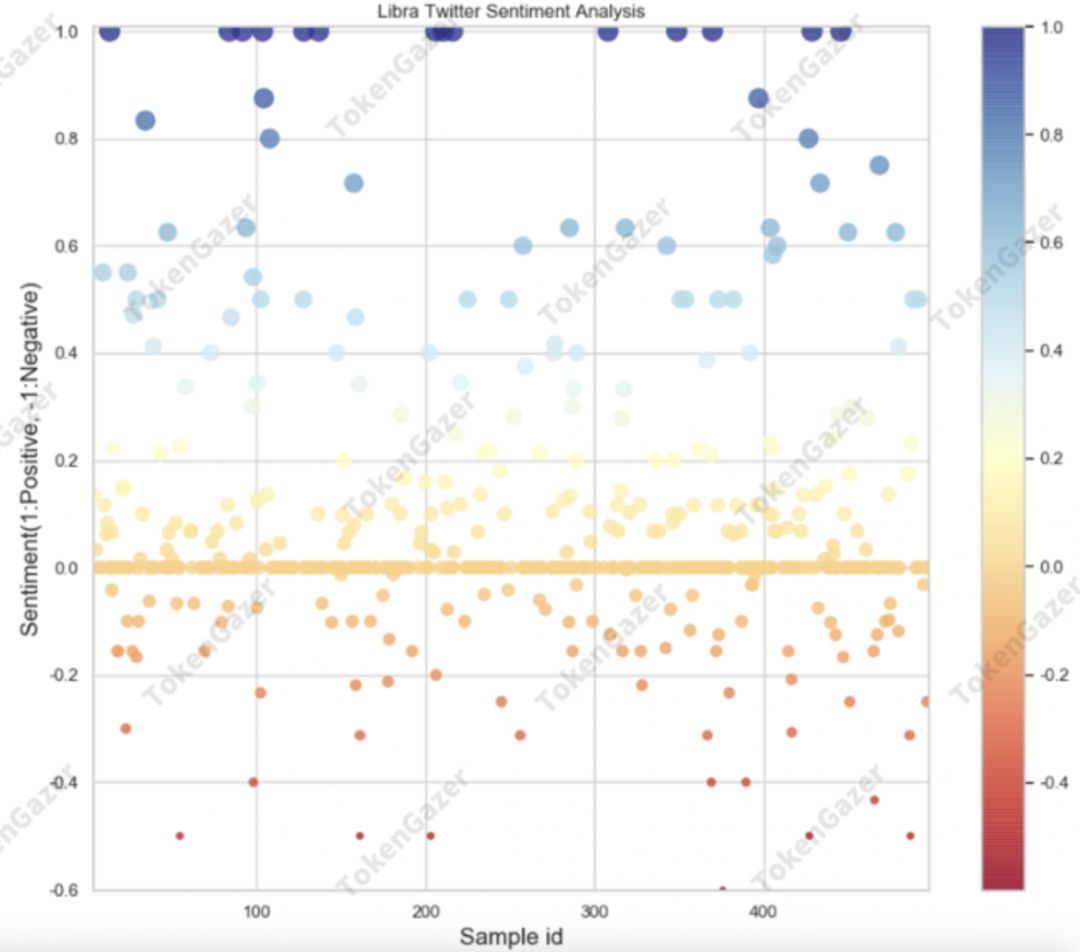
Libra word cloud:
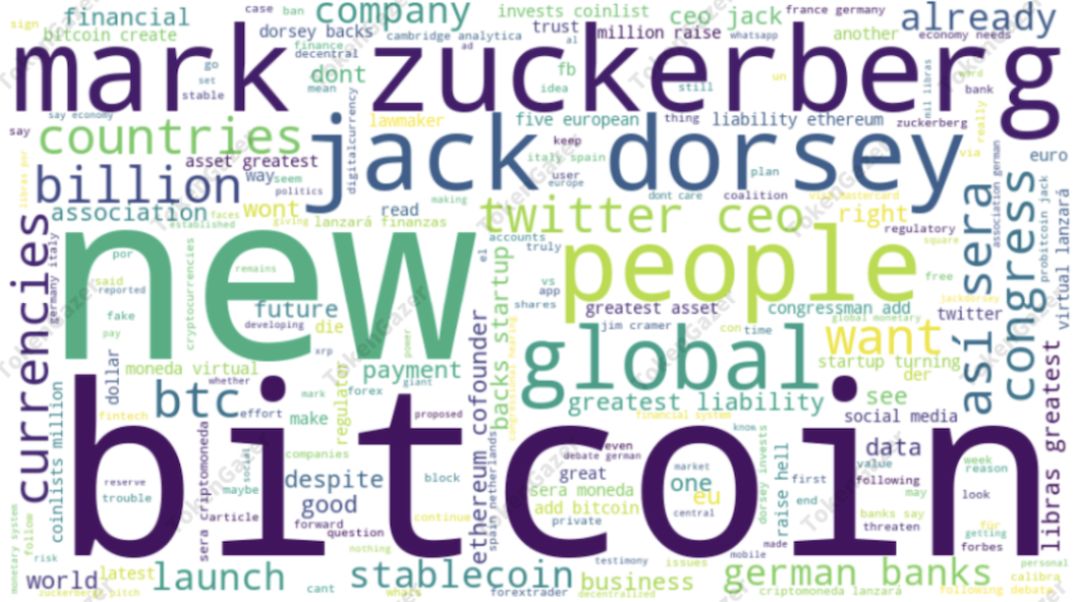
In the sample, 35% of people are positive about Facebook Libra, 49% are neutral, and the remaining 16% are negative. Compared with the emotional analysis results of DCEP, the data is more dispersed and the attitude is more polarized. In the Libra word cloud, the names of mark Zuckerberg and jack Dorsey are particularly conspicuous, and New and global are also high-frequency words.
Central Bank Digital Currency DCEP
DCEP, the full name of Digital Currency Electronic Payment, means digital currency and electronic payment tools.
DCEP issuance mechanism
Unlike Libra's release of a basket of currencies as a value support, DCEP is a complete replacement for RMB notes and coins, with its functions and attributes.
The central bank defines DCEP as a digital payment instrument with value characteristics. The so-called value feature, in simple terms, can achieve value transfer without an account. Like banknotes, DCEP does not require an account to perform value transfer activities such as payment, transfer, and so on.
DCEP is a legal currency and has unlimited legal liability. According to the "Regulations on the Administration of Renminbi of the People's Republic of China", no unit or individual may refuse to accept the RMB by means of format clauses, notices, declarations, notices, etc. – no unit or individual can refuse Accept DCEP.
Mu Changchun, director of the Digital Money Institute of the People's Bank of China, said in his course that the DCEP is released in the same way as banknotes. The process of placing banknotes is that after the People’s Bank of China prints out, the commercial bank pays the money issuing fund to the People’s Bank, then transports the banknotes to the outlets, and then the people go to the outlets to exchange the cash. The exchange of digital currency will still maintain this structure: commercial banks open accounts at the central bank, paying the reserve in full 100%, and individuals and businesses open digital wallets through commercial banks or commercial institutions.
For the user, he doesn't even need to go to the commercial bank. Just download a wallet app and register it to use it – you can receive payment from others, or you can bind the bank card to digital currency.
In this process, DCEP is replaced by M0, which is the substitute for banknotes. It cannot be M1 and M2. This means that the central bank's digital currency held by the public is still the central bank's debt, and the central bank carries out credit guarantees. Compensatory.
DCEP's two-tier operating system
The issuance of digital currency by the People's Bank of China is a very complicated project. China has a vast territory and a large population. The economic development, resource endowment and population situation vary greatly. In order to cope with this diversity and complexity, DCEP adopts a two-tier operating system. .
The upper level of the DCEP operating system is the central bank to commercial banks, and the lower level is commercial banks or commercial institutions to the public. The adoption of a two-tier operating system will help to fully mobilize the enthusiasm of the market, use market mechanisms to achieve resource allocation, mobilize the enthusiasm of commercial banks and commercial institutions, and exert social power.
The two-tier operating system is not only applicable to the DCEP exchange itself, but also to the development of technical routes. The People's Bank of China is open to the technical route of DCEP and will not interfere with the technical route selection of commercial organizations. As long as the requirements of central bank concurrency, customer experience, and technical specifications are met, commercial organizations can adopt any technical route, such as blockchain technology. The People's Bank of China is technologically neutral, and the central bank can adapt regardless of the technical route adopted by commercial organizations.
The operation system can realize system optimization, joint development and joint operation through the competitive selection of the “horse race mechanism”, which is conducive to the integration of resources and is also conducive to promoting innovation. In addition, the system allows DCEP to be promoted with the power of commercial organizations.
By 2018, Alipay can already be used in 200 countries and regions; it supports direct transactions in more than 20 currencies such as US dollars and British pounds; it can be paid across 38 countries and regions in the world. WeChat payment is also expanding rapidly. By March 2018, it has been compliant with 49 countries and regions, and can conduct cross-border transactions in 20 countries and regions, and directly trade in 16 currencies. The two-tier operating system allows Alipay and WeChat payment to be the best way for DCEP to flow freely around the world, and it is a good way to help DCEP become the world's currency.
On the other hand, a two-tier operating system can also avoid financial disintermediation. If the People's Bank adopts a single-tier operating system, that is, the People's Bank directly issues digital currency to the public, the People's Bank will become a direct competitor of commercial banks. In this case, the People's Bank of China can replace commercial banks to do all financial business. But this is unrealistic and the PBOC cannot cope with all the complicated situations.
Although DCEP adopts a two-tier operation structure, the People's Bank will not directly compete with commercial banks and commercial organizations such as Alipay and WeChat Pay, but the launch of DCEP will undoubtedly strengthen the People's Bank's control over currency circulation, and the prevention is higher. The security and convenience, as well as the wider use scenarios (such as the transfer can be made without the network) may lead to the “deposit of the deposit” of commercial banks, which will affect the stability of the financial system.
To this end, the central bank imposes restrictions on the use of DCEP, increasing the cost and institutional friction of bank deposits to DCEP. In addition, in order to guide holders to use DCEP for retail business scenarios, the central bank may also take corresponding measures. These measures may include:
Time and amount limit. The central bank may set transaction limits and balance limits based on different levels of the DCEP account, and may also set daily and annual cumulative transaction limits and provide for large redemption of appointments.
Transaction fee limit. When necessary, the central bank may implement a tiered charge for DCEP exchanges, no charge for small, low-frequency exchanges, and higher fees for large, high-frequency exchanges and transactions.
These measures can also play a role in anti-money laundering.
DCEP regulation
The public has the need for anonymous payment. In the past, banknotes can meet the public demand for anonymity, but now the electronic payment tools can not meet the anonymity needs – Internet payment and bank card payment are closely tied to the traditional bank account system. It is a tightly coupled way to the account.
At present, DCEP's information about account coupling is not clear. According to the previous speech of Fan Yifei, deputy governor of the People's Bank of China, DCEP may adopt a loosely coupled account. If the DCEP is based on the loosely coupled form of the account, he will greatly reduce the dependence of the transaction link on the account or even the account, and can maintain the properties and main value characteristics of the cash, and meet the requirements of the public for portability and anonymity.
In this case, while facilitating public payments, DCEP also needs to maintain a balance that does not facilitate crime. In terms of anonymity, the central bank's digital currency must achieve controllable anonymity, and only disclose the transaction data to the central bank. The reason is that if there is no transaction third party anonymity, personal information and privacy will be revealed; but if full third party anonymity is allowed, it will promote crimes such as tax evasion, terrorist financing and money laundering.
In the case of DCEP adopting a loosely coupled account system, the PBC can require operators to transmit transaction data asynchronously to the central bank on a daily basis, which is convenient for the central bank to grasp the necessary data to ensure that regulatory objectives such as prudent management and anti-money laundering can be achieved and mitigated. The system burden of commercial institutions. The People's Bank of China can use big data to carry out anti-money laundering, anti-tax evasion, and anti-terrorist financing. That is to say, although ordinary transactions are anonymous, according to the big data analysis of behavioral characteristics, the People's Bank can lock in personal money laundering behavior and real identity.
In addition, due to anti-money laundering considerations, the People's Bank of China will restrict the use of DCEP. In addition to the restrictions on time, amount, and transaction fees mentioned above, Mu Changchun said that the People's Bank also has a rating and quota for digital wallets. Arranged. For example, an unauthenticated wallet can only meet the daily micropayment needs; but if you bind an ID card or a bank card, you can get a higher level wallet; you can get a wallet with no limit when you go to the counter.
DCEP technical architecture
DCEP uses a hybrid architecture, but as mentioned earlier, DCEP's hybrid architecture does not pre-set any technical route.
Mu Changchun said, "At present, it belongs to a horse racing state. Several designated operating agencies adopt different technical routes to do DCEP research and development. Whose route is good, who will eventually be accepted by the people and accepted by the market, who will eventually win the game. So this is the process of market competition selection."
At present, there is not much information disclosure on the technical routes adopted by various agencies. However, it is worth mentioning that due to the high concurrency requirements of DCEP (at least 300,000 transactions per second), DCEP does not use blockchain technology in the PBC layer of the two-tier operating system. Blockchain technology cannot meet this high concurrency requirement in performance. However, for the intelligent contract function that can be automatically executed in the blockchain technology, Fan Yifei pointed out that smart contracts that are beneficial to the monetary function can be considered, but should be cautious for smart contracts that exceed the monetary function.
DCEP's social media response
We collected the latest 500 tweets on Twitter with the keyword “DCEP”. After data filtering, we obtained the following analysis data.
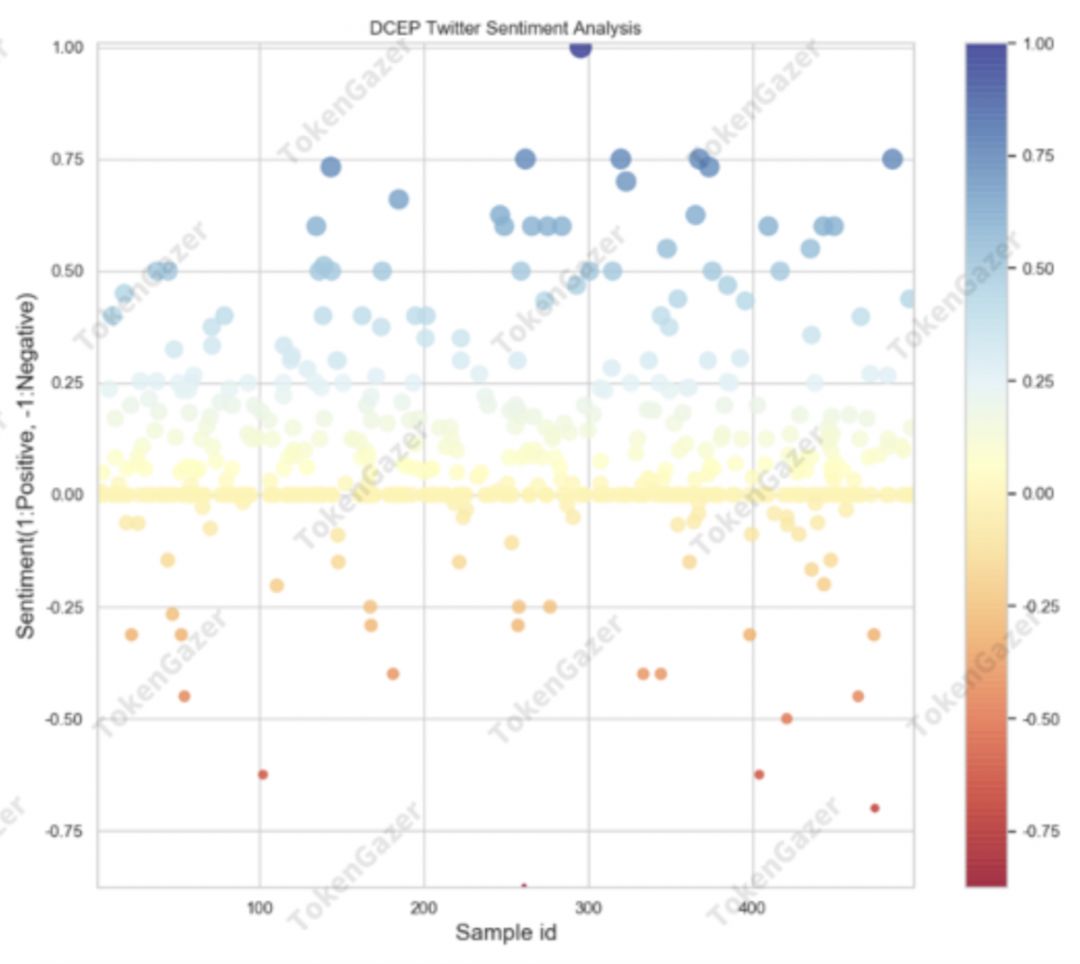
DCEP Twitter sentiment analysis
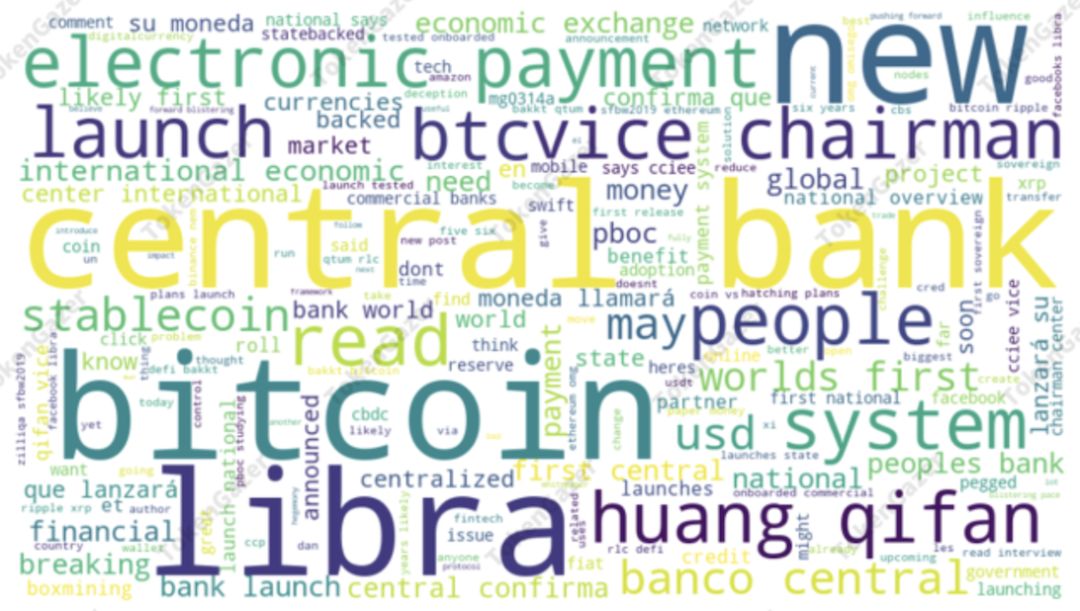
DCEP Twitter word cloud
The results of sentiment analysis showed that 53% of the sample data had a positive attitude toward the central bank DCEP, 36% remained neutral, and the remaining 11% were negative. It can be observed through the Twitter word cloud that when people talk about DCEP, they tend to associate it with bitcoin, Libra, and stablecoin. New, worlds first are often used to describe DCEP. At the same time btcvice is also a high frequency word.
List of other countries' digital currencies
The Block, a cryptocurrency research institution, surveyed central banks in more than 60 countries, and 18 have publicly announced the development or pilot program of digital currency issued by the state. One of the earliest examples is the digital currency of Ecuador, which was announced in 2014 and officially launched in 2015. According to the research institute Cato Institute, the digital currency project in Ecuador was eventually closed in 2018 due to a lack of users and payments.
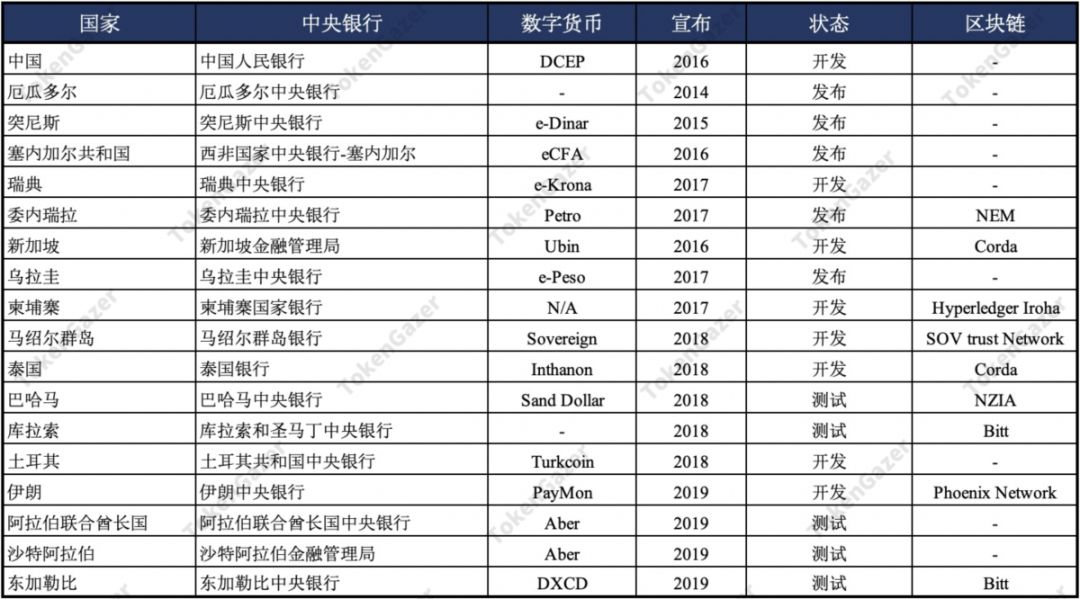
As you can see in the chart above, at least five countries/central banks have announced and issued their own digital currency. The remaining 13 are developing or launching pilot programs with third-party blockchain software providers. The above chart does not include countries that declare “considering” the issue of digital currency or “researching” digital currency.
to sum up
Libra's distribution mechanism, membership, and global customers have received many questions from Libra on global stability, such as financial stability and public policy, governance, anti-money laundering, and operational stability. On the contrary, the DCP of the People's Bank of China is clear in terms of monetary policy and regulatory framework. It is reflected in social media, and the evaluation of Libra is relatively negative, while it is relatively positive for DCEP.
From the current global infrastructure and business realities of global payments, the emerging payment and transfer systems for independent architectures for global markets are almost blank, limited by complex international regulations and the vastly different legal frameworks of countries, currently cross-border Payment transfers and liquidation still rely on FEDWIRE (Federal Electronic Funds Transfer System) and CHIPS (Clearing Interbank Payment Clearing System) that support US dollar global clearing. Only partially decentralized distributed ledger technologies such as Bitcoin, Ethereum, etc. are applied to a few edge scenarios and services. The new infrastructure that can effectively improve the efficiency of current international transfers and clearing will be a huge blue ocean.
The global customer base of Facebook and Libra members is Libra's strong backing for this new international infrastructure. In contrast, DCEP and China's payment business and blockchain infrastructure have a relatively small global customer base. The internationalization path of DCEP is not clear, and perhaps only the path of internationalization is constantly being explored.
Copyright Information and Disclaimer
Unless otherwise stated herein, all content is original and researched and produced by TokenGazer. No part of this content may be reproduced in any form or in any other publication without the express consent of TokenGazer.
TokenGazer's logos, graphics, logos, trademarks, service marks and titles are TokenGazer Inc.'s service marks, trademarks (whether registered or not) and/or trade dress. All other trademarks, company names, logos, service marks and/or trade dress ("Third Party Trademarks") mentioned, displayed, quoted or otherwise indicated herein are the exclusive property of their respective owners. . You may not copy, download, display, use as a meta-tag, misuse or otherwise utilize a mark or third-party mark without the prior written permission of TokenGazer or the owner of such third party mark. .
This document is for informational purposes only and all information contained herein should not be used as a basis for investment decisions.
This document does not constitute investment advice or assist in determining specific investment objectives, financial conditions and other investor needs. If investors are interested in investing in digital assets, they should consult their own investment advisors. Investors should not rely on this article for legal, tax or investment advice.
The asset prices and intrinsic values mentioned in this study are not static. The past performance of an asset cannot be used as a basis for future performance of any of the assets described herein. The value, price or income of certain investments may be adversely affected by exchange rate fluctuations.
Certain statements contained herein may be TokenGazer's assumptions about future expectations and other forward-looking statements, and known and unknown risks and uncertainties that may cause actual results, performance or events and statements and Suppose there is a substantial difference.
In addition to forward-looking statements as a result of contextual derivation, there are words of “may, future, should, may, can, expect, plan, intend, anticipate, believe, estimate, predict, potential, predict or continue” Similar expressions identify forward-looking statements. TokenGazer is not obligated to update any forward-looking statements contained herein, and Buyer shall not place excessive reasons on such statements, which merely represent opinions prior to the deadline. While TokenGazer has taken reasonable care to ensure that the information contained herein is accurate, TokenGazer makes no representations or warranties, either expressed or implied, including the liability of third parties, for its accuracy, reliability or completeness. You should not make any investment decisions based on these inferences and assumptions.
Investment risk warning
Price fluctuations: In the past, digital currency assets have single-day and post-price fluctuations.
Market acceptance: Digital assets may never be widely adopted by the market, in which case single or multiple digital assets may lose most of their value.
Government regulations: The regulatory framework for digital assets remains unclear, and regulatory and regulatory restrictions on existing applications may have a significant impact on the value of digital assets.
This article is the original content of TokenGazer, please indicate the source.
We will continue to update Blocking; if you have any questions or suggestions, please contact us!
Was this article helpful?
93 out of 132 found this helpful
Related articles
- Ethereum Enterprise Alliance, in conjunction with Microsoft, IBM, etc., launched a general classification of standards to promote cross-platform transactions
- People's Daily Ye Hao: Promoting the safe and orderly development of blockchain
- The Fed is hiring digital currency executives, and the “Join Refund” plan has been forced to restart?
- Data: Bitcoin has outperformed gold for 10 consecutive years. How about 2020?
- Monthly News | SEC Deterrence: October IEO, STO financing amount is 0, ICO fell by 95%
- BTC tested the upper resistance in the early morning, and the disk gradually stabilized.
- Zhu Jiaming: The central government advocates blockchain and incorporates scientific and technological elements into the concept of governing the country. Its historical significance cannot be underestimated.



